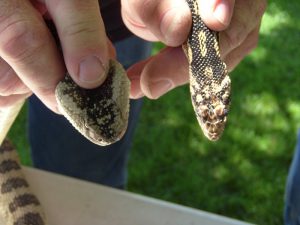We were at our San Diego home and one of our renter’s cats caught a baby snake (which we of course saved) – and it got me thinking about the baby snakes joining the baby birds, rabbits and other mammals being born as spring ramps into full-time. I checked in with Dr. William Hayes, a herpetologist at Loma Linda University, and he provided the following info:

Most common snakes in Southern California this time of year are:
- gopher snakes
- western coachwhips (also known as red racers)
- Less common: California kingsnakes and rosy boas (in rocky areas). In some areas, rattlesnakes can be as common as the non-venomous snakes.
Snakes In Search for Sex Hayes said spring is the mating season, so the males in particular travel considerable distances looking for mates, while both sexes are on the hunt for food. “As the season warms, most of these species will shift toward becoming nocturnal, especially in the hotter desert regions. They generally retreat to shade in the heat of the day, but may emerge a few hours before dark and be active a few hours in the morning,” he said.
Baby rattlesnakes Do Bite – Hayes said that with only one or two rattle segments at this time of year, baby rattlers will not be very audible with their rattling. “Fortunately, although they could potentially strike their entire body length, the babies can’t cover much distance in their strike. The adults, in contrast, can only strike about one-third their length, but this could be similar to the distance a baby is capable of lunging,” he said, adding to always stay at least three feet away from a rattlesnake. “Some kids and adult males (the combination of testosterone and alcohol are particularly deadly) may try to imitate the snake handlers they see on TV by grabbing a baby rattler by the tail, but this is a huge mistake, as the babies are much more likely than the adult to succeed in biting when grasped in this way. Although the babies have less venom available in their glands than the adults, and use less venom when they bite (contrary to popular myth), they still pack quite a punch and can cause serious injury to pets and humans alike. They need to be left alone.”
If you’re interested in more rattlesnake info, see my prior post Some Truths about Rattlesnakes (and myth debunking )
Why you might hear that snakes are active unusually early” Hayes explains that temperature is the biggest factor affecting movement. Snakes remain underground when it is cold, and become active when it’s warm. “During warm spells, with sunny temperatures above 65-70 F, snakes will be out and about, looking for food and mates. This can happen even during the winter months, when we’ve occasionally seen rattlesnakes consume a meal. That’s life here in southern California,” he said.


Leave a Reply